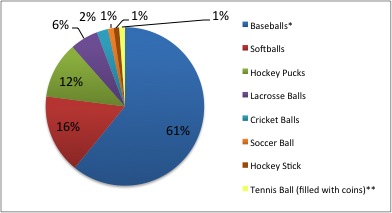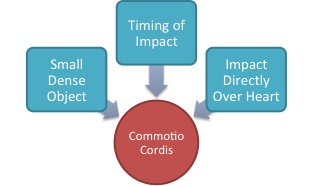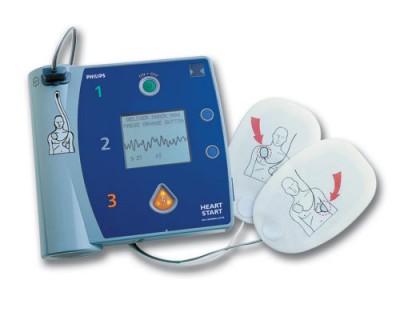Commotio Cordis refers to the sudden arrhythmic death caused by a low/mild chest wall impact. Commotio Cordis is seen mostly in athletes between the ages of 8 and 18 who are partaking in sports with projectiles such as baseballs, hockey pucks, or lacrosse balls. These projectiles can strike the athletes in the middle of the chest with a low impact but enough to cause the heart to enter an arrhythmia. Martial arts is a sport in which a strike of a hand can also cause the heart to change it’s rhythm. Without immediate CPR and defibrillation the prognosis of commotio cordis is not very good. This condition is extremely dangerous with rare survival.
How do you prevent commotio cordis?
- Have an athletic trainer present at practices and games
- Educate coaches, parents, and athletes how to perform CPR and use an AED
- Educate coaches, parents, and athletes of signs of commotio cordis
- Have an AED accessible near playing fields at all times
- Ensure coaches know where to locate the AED
- Ensure there is an Emergency Action Plan in place
- Ensure protective equipment is properly fitted
- Teach athletes how to avoid being hit with a ball/puck
- Avoid strength disparities among participants and coaches
- Use safety baseballs
Commotio cordis caused from sports equipment. * Includes 4 T-balls. **Training device used for baseball pitchers. Adapted from: Maron BJ, Gohman TE, Kyle SB, Estes NAM, Link, M. Clinical profile and spectrum of commotio cordis.J Am Med Assoc. 2002;287(9):1142-1146.
**You can see from the above figure that the majority of cases of commotio cordis occurred with baseballs**
Look for these symptoms in athletes when commotio cordis is suspected:
- Look for an athlete who was hit in the chest by an object such as a baseball, baseball bat, or lacrosse ball
- There should be no apparant trauma
- The athlete will typically stumble forward for a few seconds, which is followed by unconsciousness, no breathing, and no pulse
- An AED will indicate the athlete is in ventricular fibrillation
- Factors leading to commotio cordis include:
“Timing of Impact” refers to the timing of the object hitting the chest during the cardiac cycle. The heart is most vulnerable when it is struck at the beginning of the T-wave. This part of the cycle indicates the refilling of the heart’s ventricles.
What else could this be?
- This condition could be confused with the following conditions due to similar presentation:
- Cardiac Arrest
- Pulmonary Conditions
- Hypertrophic Cardiomyopathy
- Concussion
- Heat Syncope
How do you treat an individual with commotio cordis?
- Use an AED and defibrillate as quickly as possible. For every 1 minute delay in getting shocked by the AED there is a 10% decline in survival rate. Using an AED is the best practice and gives the athlete the greatest chance of survival.
- Immediately activate EMS and the school’s Emergency Action Plan.
- Continue AED use and CPR until EMS arrives and takes over.
When can the individual return to activity?
- Before returning to play that athlete should have a cardiac evaluation including ECG by the athlete’s physician.
- Physician clearance is necessary before returning to practice.
- The athletic trainer should use clinical judgement during return to play and should carefully watch the athlete to ensure a cardiac episode does not occur.
- Adjust practice by adding personal protection such as chest padding or switching to safety balls to decrease the chance of another incident.
References
- Koehler SA, Shakir A, Ladham S, Rozin L, Omalu B, Dominick J, Wecht CH. Cardiac contusion: definition, differential diagnosis, and cases presentation and the legal ramification of a misdiagnosis. Am J Foren Med Path. 2004;25(3):205-208.
- Link MS, Wang PJ, Pandian NG, Bharati S, Udelson JE, Lee MY, Vecchiotti MA, VanderBrink BA, Mirra G, Maron BJ, Estes NA. An experimental model of sudden death due to low-energy chest-wall impact. New Engl J Med. 1998;338:1805-1811.
- Maron BJ, Estes, NAM, Link MS. Task force 11: commotio cordis. J Am Coll Cardio. 2005;45:1371-1373.
- Maron BJ, Gohman TE, Kyle SB, Estes NAM, Link, M. Clinical profile and spectrum of commotio cordis. J Am Med Assoc. 2002;287(9):1142-1146.
- Maron BJ, Poliac LC, Kaplan JA, Mueller FO. Blunt impact to the chest leading to sudden death from cardiac arrest during sports activity. New Engl J Med. 1995;333:337-342.
- Salib EA, Cyran SE, Cilley RE, Maron BJ, Thomas NJ. Efficacy of bystander cardiopulmonary resuscitation and out-of-hospital automated external defibrillation as life-saving therapy in commotio cordis. J Pediat, 2005;147:863-866.



